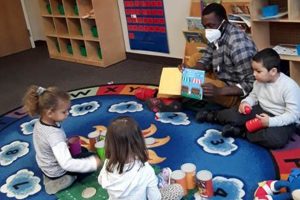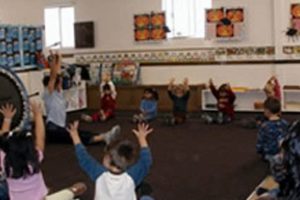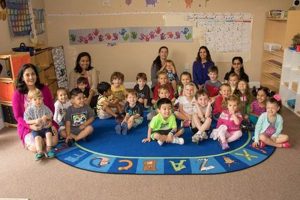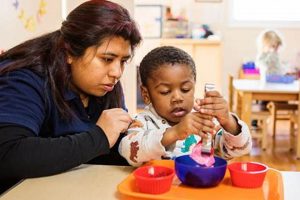A play-based learning environment grounded in the Montessori educational method, often for children aged two-and-a-half to six years old, embodies this concept. Such programs typically offer hands-on activities designed to foster independence, creativity, and a love of learning through self-directed exploration in prepared environments. These environments are carefully curated with age-appropriate materials that encourage children to develop at their own pace across various developmental domains, including practical life skills, sensorial exploration, language arts, mathematics, and cultural studies.
Early childhood education programs emphasizing self-directed learning and hands-on experiences provide numerous benefits. These approaches nurture a child’s natural curiosity and desire to learn, laying a strong foundation for future academic success. By providing opportunities for children to make choices and solve problems independently, such programs cultivate critical thinking skills, creativity, and a sense of self-reliance. Furthermore, they foster social-emotional development by encouraging collaboration, respect, and empathy within a mixed-age learning environment. The historical context of this approach is rooted in the work of Dr. Maria Montessori, an Italian physician and educator who developed the Montessori method in the early 20th century. Her observations of children’s natural learning processes led to an educational philosophy that emphasizes self-directed activity, hands-on learning, and collaborative play.
Understanding the principles and practical application of this educational philosophy is essential for educators, parents, and anyone interested in early childhood development. Exploring topics such as curriculum design, classroom management, and parent-teacher partnerships will provide a more comprehensive understanding of this unique and effective approach to early childhood education.
Tips for Fostering a Montessori Learning Environment at Home
Creating a supportive and engaging learning environment at home can significantly enhance a child’s educational journey. These tips offer practical guidance for parents seeking to extend Montessori principles beyond the classroom.
Tip 1: Establish a Prepared Environment: Designate specific areas for different activities, ensuring easy access to age-appropriate materials. Organized shelves with clearly labeled containers promote independence and self-directed learning.
Tip 2: Encourage Practical Life Skills: Incorporate everyday tasks into a child’s routine, such as setting the table, folding laundry, and preparing simple snacks. These activities develop fine motor skills, concentration, and a sense of responsibility.
Tip 3: Embrace Sensorial Exploration: Provide opportunities for children to engage their senses through activities like sorting objects by color, texture, or size. This type of exploration refines sensory perception and cognitive development.
Tip 4: Foster Independence: Allow children to choose activities and work at their own pace. Offer guidance when needed, but avoid interrupting their concentration unless necessary. This promotes self-reliance and problem-solving skills.
Tip 5: Observe and Adapt: Pay attention to a child’s interests and adjust the learning environment accordingly. Introduce new materials and activities that align with their developmental stage and curiosity.
Tip 6: Limit Screen Time: Minimize exposure to screens and prioritize hands-on activities that encourage creativity and imagination. Unstructured playtime and outdoor exploration are essential for healthy development.
Tip 7: Value Process over Product: Focus on the learning process rather than the end result. Encourage children to experiment, make mistakes, and learn from their experiences without the pressure of achieving perfection.
By implementing these strategies, parents can cultivate a home environment that supports a child’s natural love of learning, fosters independence, and promotes holistic development. These practices extend the benefits of a Montessori education beyond the classroom, creating a consistent and enriching learning experience.
Understanding these practical applications offers valuable insights for parents and educators seeking to create optimal learning environments. The following conclusion will further emphasize the importance of these principles in fostering a lifelong love of learning.
1. Child-Centered Learning
Child-centered learning forms the cornerstone of a play-based learning environment grounded in the Montessori method. This approach prioritizes the individual needs, interests, and developmental pace of each child. Rather than imposing a standardized curriculum, educators create a prepared environment rich with opportunities for self-directed exploration and discovery. Children choose activities that resonate with their current interests and developmental stage, fostering intrinsic motivation and a genuine love of learning. This emphasis on individualized learning ensures that each child receives the appropriate level of challenge and support, maximizing their potential for growth. For example, a child fascinated by botany might spend extended periods exploring the plant life in the classroom’s designated nature area, while another child developing fine motor skills might choose to work with puzzles or manipulatives. This flexibility allows children to learn at their own pace and in a way that feels natural and engaging.
The practical significance of this approach lies in its ability to cultivate essential skills beyond traditional academic subjects. Child-centered learning fosters independence, problem-solving abilities, and critical thinking. By allowing children to make choices and pursue their interests, these programs nurture self-reliance, resilience, and a sense of ownership over their learning journey. Furthermore, this approach supports social-emotional development by encouraging collaboration, empathy, and respect within a mixed-age learning environment. For example, older children often mentor younger children, reinforcing their understanding of concepts while simultaneously developing leadership and communication skills. This type of peer-to-peer learning fosters a sense of community and mutual support within the classroom.
In summary, prioritizing the child’s individual needs and interests cultivates intrinsic motivation, deep understanding, and the development of essential life skills. While standardization often emphasizes uniformity and measurable outcomes, child-centered learning recognizes the unique potential within each child. By embracing individual differences and fostering a love of learning, this approach empowers children to become confident, self-directed learners equipped to thrive in a complex and ever-changing world. Addressing the inherent challenges in tailoring educational experiences to individual needs while maintaining a cohesive learning environment remains crucial for successful implementation. This child-centric approach recognizes that effective education requires not only the transmission of knowledge but also the cultivation of a lifelong love of learning.
2. Hands-on Exploration
Hands-on exploration forms a cornerstone of the educational philosophy characterizing a play-based learning environment grounded in the Montessori method. This approach recognizes the profound impact of direct sensory experience on a child’s cognitive, social, and emotional development. By actively engaging with materials and manipulating objects, children construct their understanding of the world around them. This process of discovery fosters deep and meaningful learning, moving beyond rote memorization to genuine comprehension. For example, a child exploring geometric solids not only learns their names but also internalizes their properties through touch and manipulation, developing a concrete understanding of spatial relationships. Similarly, engaging with a set of musical instruments allows children to experiment with sound, rhythm, and melody, fostering creativity and an appreciation for music. Cause and effect relationships are explored through activities like pouring water from one container to another or building structures with blocks, developing critical thinking and problem-solving skills.
The importance of this hands-on engagement lies in its alignment with children’s natural learning processes. Young children are inherently driven to explore their environment, touching, tasting, and manipulating everything within their reach. This innate curiosity serves as a powerful engine for learning. By providing a rich and stimulating environment filled with carefully chosen materials, educators leverage this natural drive to foster intellectual growth and a lifelong love of learning. Practical applications of this principle can be observed in the design of Montessori classrooms. Activities such as pouring, scooping, and sorting, often categorized as “practical life” exercises, develop fine motor skills while also providing opportunities for concentration and problem-solving. These seemingly simple activities lay the foundation for more complex learning experiences, preparing children for future academic challenges. Furthermore, hands-on exploration fosters independence and self-reliance. Children are encouraged to choose activities, work at their own pace, and solve problems independently, building confidence in their abilities and a sense of ownership over their learning process.
In summary, hands-on exploration serves as a crucial catalyst for deep and meaningful learning in early childhood education. This approach recognizes the inherent value of direct sensory experience in constructing knowledge and understanding. By providing opportunities for children to actively engage with their environment, educators tap into their natural curiosity, fostering not only cognitive development but also essential life skills such as problem-solving, independence, and a lifelong love of learning. Integrating hands-on exploration effectively presents challenges in maintaining a balance between structured guidance and open-ended discovery. However, its crucial role in fostering genuine understanding and intrinsic motivation solidifies its position as a fundamental element of this educational approach. The focus on tangible interaction with the world fosters a deeper connection to learning, laying the foundation for future academic success and a lifelong thirst for knowledge.
3. Prepared Environment
A prepared environment is fundamental to a play-based learning experience rooted in the Montessori philosophy. It serves as the backdrop for self-directed activity and hands-on exploration, carefully designed to foster independence, concentration, and a love of learning. This environment is not merely a physical space, but a thoughtfully curated ecosystem of materials, activities, and social interactions. Key characteristics include order, accessibility, and beauty. Materials are arranged systematically on open shelves, allowing children to independently select and return items. Activities cater to varying developmental stages and interests, promoting engagement and individualized learning. Aesthetically pleasing surroundings, incorporating natural light and elements of nature, create a calming and inspiring atmosphere conducive to focused work.
The prepared environment’s impact on learning is significant. Accessibility empowers children to take ownership of their learning journey, fostering self-reliance and initiative. Order promotes concentration and a sense of calm, allowing children to delve deeply into chosen activities. Beauty cultivates an appreciation for aesthetics and inspires creativity. Real-life examples illustrate this impact. A low shelf containing carefully arranged pouring activities encourages a child to practice fine motor skills and concentration. A designated art area stocked with readily available materials fosters creative expression. A quiet reading nook with comfortable cushions invites exploration of literature. These carefully designed spaces support children’s natural curiosity and facilitate self-directed learning.
Understanding the significance of the prepared environment offers practical applications for educators and parents alike. Creating such an environment, whether in a classroom or at home, requires careful consideration of the child’s developmental needs and interests. Thoughtful organization, accessibility of materials, and attention to aesthetics contribute significantly to a child’s learning experience. Challenges include adapting the environment to evolving needs and maintaining a balance between structure and freedom. However, the prepared environment’s essential role in fostering independence, concentration, and a love of learning solidifies its importance within this educational approach. Its influence extends beyond immediate skill development, cultivating a mindset of self-directed learning and a lifelong appreciation for exploration and discovery.
4. Self-Directed Activity
Self-directed activity lies at the heart of a play-based learning environment grounded in the Montessori method, often referred to using the keyword phrase “pok pok montessori preschool.” This educational approach recognizes the intrinsic motivation of children to explore, discover, and learn at their own pace. Providing opportunities for self-directed activity cultivates independence, problem-solving skills, and a sense of ownership over the learning process. Children are empowered to choose activities that align with their interests and developmental stage, fostering deep engagement and a genuine love of learning. This contrasts sharply with traditional didactic approaches where learning is often teacher-directed and focused on rote memorization. For example, within a prepared environment, a child might choose to work with a set of geometric solids, exploring their shapes and properties independently, or select a book from a readily accessible shelf, fostering a love of reading at their own pace. These choices empower the child to direct their learning journey, building confidence and self-reliance.
Practical applications of this principle are evident in the design and functioning of classrooms employing this educational approach. Materials are organized and accessible, allowing children to independently select and utilize them. Uninterrupted work periods are provided, fostering concentration and deep engagement with chosen activities. The teacher acts as a guide and facilitator, observing children’s interests and providing support when needed, rather than dictating the learning process. This fosters a sense of autonomy and responsibility for one’s learning, essential skills for lifelong success. For example, a child struggling with a particular puzzle might seek guidance from the teacher, receiving just enough support to overcome the challenge independently, reinforcing problem-solving skills and building resilience. The mixed-age classroom setting further promotes self-directed learning as older children often mentor younger children, reinforcing their own understanding of concepts while simultaneously developing leadership and communication skills.
In summary, self-directed activity is not merely a component but a defining characteristic of this educational approach. It fosters essential skills such as independence, problem-solving, and intrinsic motivation. While challenges exist in balancing freedom with structure and ensuring appropriate levels of guidance, the profound impact of self-directed activity on a child’s cognitive, social, and emotional development solidifies its central role. This approach empowers children to become active participants in their education, cultivating a lifelong love of learning and a mindset of continuous growth. Its focus on intrinsic motivation and self-reliance lays a strong foundation for future academic success and overall well-being.
5. Holistic Development
Holistic development represents a core principle of play-based learning environments grounded in the Montessori method, often referred to by the keyword phrase “pok pok montessori preschool.” This approach recognizes the interconnectedness of a child’s cognitive, social, emotional, and physical development. Rather than focusing solely on academic achievement, it emphasizes nurturing the whole child, fostering well-rounded individuals equipped to thrive in all aspects of life. This interconnectedness is evident in the design of the prepared environment and the selection of activities. For example, practical life activities such as pouring, buttoning, and food preparation not only develop fine motor skills but also foster concentration, independence, and a sense of order. Sensorial materials, designed to refine sensory perception, indirectly contribute to cognitive development by enhancing a child’s ability to process and categorize information. Collaborative work within the classroom promotes social skills and emotional intelligence as children learn to negotiate, share, and resolve conflicts. Outdoor play and movement activities support physical development and provide opportunities for gross motor skill development, contributing to overall well-being.
Practical applications of this holistic approach are evident in the daily routines and activities within these learning environments. Mixed-age classrooms provide opportunities for social interaction and peer learning, fostering empathy and cooperation. Emphasis on self-directed activity promotes self-regulation and emotional intelligence as children learn to manage their time, make choices, and persevere through challenges. Opportunities for creative expression through art, music, and dramatic play nurture imagination and emotional well-being. Furthermore, integrating nature and outdoor exploration provides opportunities for physical activity and fosters a connection with the natural world, contributing to overall health and well-being. The impact extends beyond the immediate classroom, equipping children with essential life skills that contribute to their long-term success and happiness.
In summary, holistic development serves as a guiding principle, shaping the curriculum, the environment, and the teacher’s role. It recognizes the importance of nurturing all aspects of a child’s development, fostering well-rounded individuals prepared for the complexities of life. While challenges exist in balancing the various developmental domains and tailoring approaches to individual needs, the focus on holistic development remains a defining characteristic of this educational approach. It offers a powerful framework for fostering not only academic success but also social-emotional intelligence, physical well-being, and a lifelong love of learning. This integrated approach prepares children not just for school, but for life, equipping them with the skills and dispositions necessary to thrive in a complex and ever-changing world.
Frequently Asked Questions
This section addresses common inquiries regarding play-based learning environments grounded in the Montessori method, often referred to using the keyword phrase “pok pok montessori preschool.”
Question 1: How does a Montessori classroom differ from a traditional preschool setting?
Montessori classrooms emphasize self-directed activity and hands-on learning within a prepared environment, while traditional preschools often follow a more structured, teacher-directed curriculum.
Question 2: What is the role of the teacher in a Montessori classroom?
The teacher acts as a guide and facilitator, observing children’s interests and providing individualized support, rather than directing all learning activities.
Question 3: Are Montessori programs suitable for all children?
While the Montessori method can benefit a wide range of learners, its suitability depends on individual learning styles and preferences. Observing a classroom and discussing a child’s specific needs with educators can help determine if it’s the right fit.
Question 4: How does the mixed-age grouping in Montessori classrooms benefit children?
Mixed-age groupings foster peer learning, social development, and a sense of community. Younger children learn from older peers, while older children develop leadership and mentoring skills.
Question 5: What is the emphasis on practical life skills in a Montessori curriculum?
Practical life activities, such as pouring, buttoning, and food preparation, develop fine motor skills, concentration, and independence, laying a foundation for future academic learning.
Question 6: How does a Montessori education prepare children for future academic success?
By fostering self-directed learning, critical thinking, and problem-solving skills, a Montessori education equips children with the foundational skills and dispositions necessary for lifelong learning and academic achievement.
Understanding these key aspects provides a foundation for informed decision-making regarding early childhood education. Further exploration of specific program offerings can provide a more comprehensive understanding.
This concludes the FAQ section. The following section will delve deeper into specific aspects of Montessori education.
Conclusion
Play-based learning environments grounded in the Montessori method, often referred to by the keyword phrase “pok pok montessori preschool,” offer a distinctive approach to early childhood education. This exploration has highlighted key elements, including child-centered learning, hands-on exploration, the prepared environment, self-directed activity, and holistic development. These interconnected principles create a nurturing and stimulating learning experience, fostering independence, critical thinking, and a lifelong love of learning. The emphasis on individualized learning journeys respects each child’s unique developmental pace and interests, empowering them to become confident, self-reliant learners.
The significance of these environments lies in their potential to cultivate not only academic readiness but also essential life skills. The focus on self-directed activity empowers children to take ownership of their learning, fostering intrinsic motivation and a sense of purpose. Further investigation into the practical application of these principles within specific educational settings is encouraged for a more comprehensive understanding of their impact on early childhood development. The future of education hinges on fostering adaptable, resilient learners equipped to thrive in a complex and ever-changing world, and these environments provide a promising model for achieving this goal.







